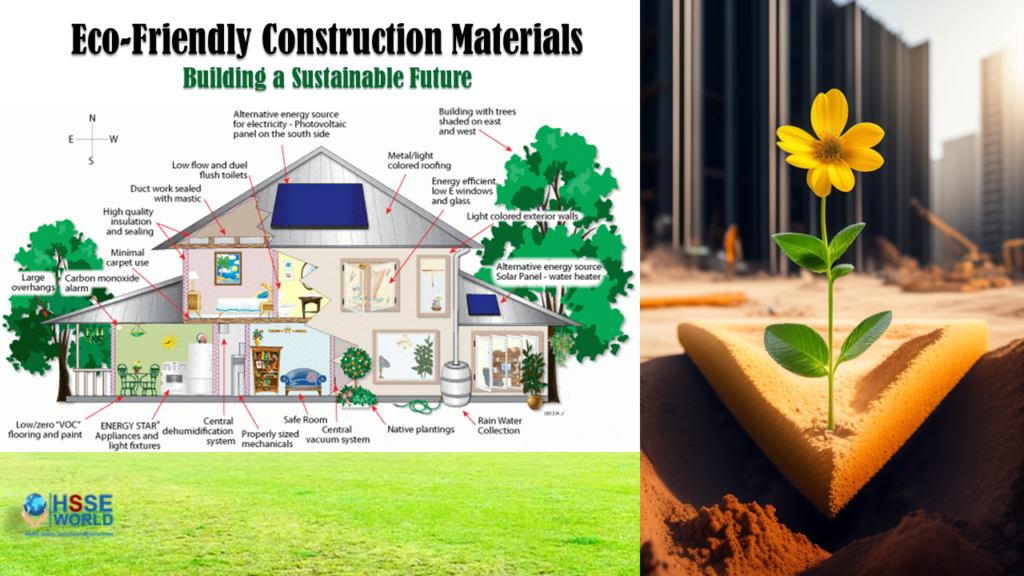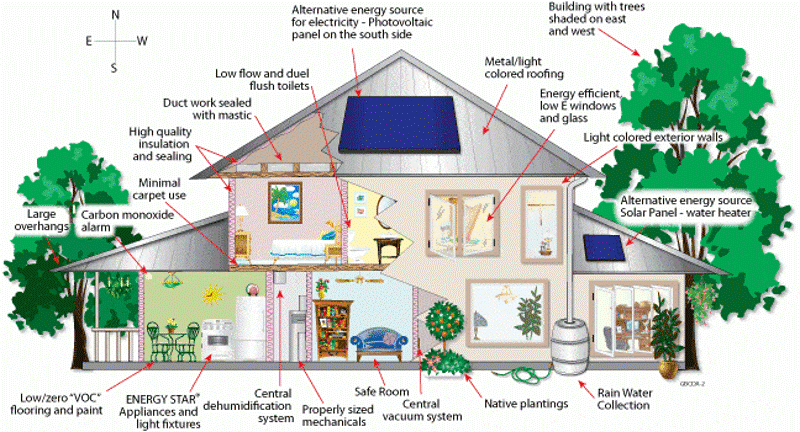The construction industry has a significant impact on the environment, from the extraction of raw materials to the generation of waste. However, as we become more aware of the need for sustainable practices, the demand for eco-friendly construction materials is on the rise. These materials offer a way to reduce the environmental footprint of construction projects while creating a more sustainable future. In this blog post, we will explore the importance of eco-friendly construction materials and how they can contribute to building a greener and more sustainable world.
Also Read: E-Books:Introduction to Environmental Management

The Need for Eco-Friendly Construction Materials
Traditional construction materials, such as concrete and steel, have a substantial environmental impact. They contribute to greenhouse gas emissions, deplete natural resources, and generate large amounts of waste. With the growing awareness of climate change and environmental degradation, there is a pressing need to shift towards eco-friendly alternatives.
Eco-friendly construction materials offer several benefits. They help reduce carbon emissions, conserve natural resources, and improve indoor air quality. Additionally, they often have lower energy requirements during manufacturing and installation, making them more energy-efficient overall.
Types of Eco-Friendly Construction Materials
There is a wide range of eco-friendly construction materials available today. Let’s explore some of the most popular options:
Recycled and reclaimed materials: Materials such as recycled steel, reclaimed wood, and recycled plastic are gaining popularity in construction projects. These materials not only reduce waste but also offer unique aesthetics and durability.
Also Read: Air Emissions Mangement Tips
Low-emission materials: Low-VOC (volatile organic compound) paints, adhesives, and sealants are examples of low-emission materials that minimize indoor air pollution. They contribute to better air quality and healthier living and working environments.
Sustainable insulation materials: Natural fibres, cellulose, and recycled insulation products are sustainable alternatives to traditional insulation materials. They offer excellent thermal performance while reducing energy consumption and minimizing environmental impact.
Sustainable structural materials: Engineered timber and bamboo are sustainable alternatives to concrete and steel. These materials have a lower carbon footprint and possess high strength and durability, making them suitable for various construction applications.
Energy-efficient materials and systems: High-performance windows, solar panels, and green roofs are examples of energy-efficient materials and systems. They help reduce energy consumption, lower carbon emissions, and promote renewable energy generation. When planning to install a grid-connected solar panel system, it is essential first to compare energy rates from different providers to get the best energy plan that suits your needs.
Innovations in Eco-Friendly Construction Materials
Innovation plays a crucial role in driving sustainable practices in the construction industry. Here are a few notable innovations in eco-friendly construction materials:
Biodegradable and bio-based materials: Materials made from renewable resources, such as bioplastics and bio-based composites, are gaining attention. These materials offer the potential for reduced environmental impact and improved biodegradability.
Smart materials and technologies: Intelligent materials that can adapt to environmental conditions, regulate temperature, or generate energy are revolutionizing the construction industry. Self-healing concrete, phase-changing materials, and responsive building systems are some examples of these innovative solutions.
3D printing and additive manufacturing: 3D printing and additive manufacturing technologies are transforming construction by reducing waste, energy consumption, and transportation needs. Sustainable materials, including recycled plastics and bio-based polymers, are being used to create intricate and customized structures.
Also Read: Waste Management: Waste Analysis
Implementing Eco-Friendly Materials in Construction Projects
While the availability and adoption of eco-friendly construction materials are increasing, there are still challenges to overcome. Architects, designers, and construction professionals play a crucial role in implementing these materials effectively. Collaboration with suppliers, contractors, and clients is essential to ensure the availability and feasibility of eco-friendly materials.
It is also important to address concerns regarding the cost, availability, and performance of eco-friendly materials. By showcasing successful case studies and highlighting the long-term benefits, misconceptions can be dispelled, encouraging wider adoption.
Examples of successful case studies that showcase the use of eco-friendly construction materials

Here are a few examples of successful case studies that demonstrate the use of eco-friendly construction materials:
- Bullitt Center, Seattle, Washington, USA:
The Bullitt Center is often referred to as the greenest commercial building in the world. It showcases the use of various eco-friendly construction materials and systems. The building incorporates reclaimed wood, FSC-certified timber, and low-emission materials throughout its construction. It also features energy-efficient systems, including solar panels, rainwater harvesting, and composting toilets. The Bullitt Center achieved the Living Building Challenge certification, demonstrating its commitment to sustainability. - The Edge, Amsterdam, Netherlands:
The Edge is a highly sustainable office building known for its innovative design and use of eco-friendly materials. It features a smart lighting system that adjusts based on occupancy and natural light levels. The building’s façade incorporates energy-efficient glass panels, creating a comfortable working environment while minimizing energy consumption. The Edge also utilizes sustainable materials, such as recycled carpet tiles and furniture made from recycled materials, promoting a circular economy approach. - The Crystal, London, United Kingdom:
The Crystal is a sustainable building and exhibition space that showcases eco-friendly construction materials and technologies. It utilizes a range of renewable energy sources, including solar power and ground-source heat pumps. The building’s façade incorporates high-performance glazing that maximizes natural daylight while minimizing heat gain. The Crystal also features rainwater harvesting and efficient water management systems, reducing water consumption significantly. - Pixel Building, Melbourne, Australia:
The Pixel Building is a carbon-neutral office building that exemplifies sustainable design and construction. It utilizes a combination of energy-efficient materials and systems, including photovoltaic panels, wind turbines, and a geothermal cooling system. The building’s façade incorporates recycled materials, and its interior features low-VOC paints and sustainable flooring options. The Pixel Building achieved a 6 Star Green Star rating, the highest rating for environmental performance in Australia. - The Change Initiative Building, Dubai, United Arab Emirates:
The Change Initiative Building is a LEED Platinum-certified retail and office space designed with sustainability in mind. It features a range of eco-friendly materials, such as bamboo flooring, low-emission paints, and recycled content products. The building incorporates energy-efficient systems, including LED lighting and efficient HVAC systems. The Change Initiative Building is a notable example of sustainable construction in a region known for its high energy consumption.
These case studies demonstrate the successful implementation of eco-friendly construction materials and sustainable design principles. They serve as inspiration and evidence of the feasibility and benefits of using such materials in construction projects, showcasing the potential for creating environmentally responsible buildings while maintaining functionality and aesthetics.
Also Read: Regulate your mood with Proper Hydration
Conclusion
Eco-friendly construction materials offer a sustainable alternative to traditional materials, helping to reduce the environmental impact of construction projects. By choosing these materials, we can contribute to building a greener and more sustainable future. The availability of innovative solutions and the collaboration of industry stakeholders are driving the adoption of eco-friendly materials. Together, we can create a built environment that is both environmentally friendly and socially responsible, paving the way for a sustainable future.
Also Read: Keys to Sustainable Safety and Ergonomics
For more safety Resources Please Visit Safetybagresources




